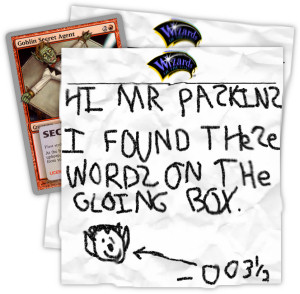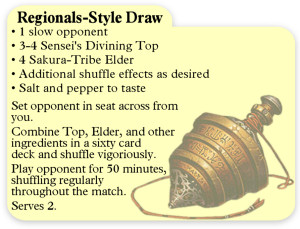“Why is playing Magic like being a professional model?”
“Because by the time you reach your mid-twenties you’re well past your best.”
Anyway, here’s what I played at Regionals:
Creatures (19)
Lands (21)
Spells (20)
- 3 Genju of the Spires
- 2 Shock
- 2 Magma Jet
- 3 Sword of Light and Shadow
- 4 Seething Song
- 4 Molten Rain
- 2 Chrome Mox
Sideboard

By way of explanation, England has regionals over a number of weeks (like Pro Tour Qualifiers), rather than all on one weekend. I hadn’t played Standard or had the chance to test for about six months, so this was more about learning (and, of course, being able to pass on what I learned 😉 than the most finely tuned version possible.
I claim no originality for this deck, though some of the numbers might be worth explaining. The idea is to try to minimize the number of useless cards that you draw. This is because Red decks (except for Mike’s deck, which I’ll talk about in a minute) have a horrible manabase with 27 mana sources and a bunch of cheap spells as you have to play Seething Song because turn 3 Arc-Slogger is so powerful against pretty much all non-Black decks (and even then, they need Terror, Rend Flesh or Nekrataal right then), and you also need to keep up with the Green decks and sometimes cast turn 1 Slith Firewalkers (though both the probability and effectiveness of this is lower than that of being able to cast turn 3 Arc-Slogger). At the same time, drawing multiple Moxes, or Seething Songs without anything to cast, probably means that you are going to lose because of the number of useless cards that you have. 3 Swords in addition to the Arc-Sloggers meant that if I drew Seething Song on turn 3 I could have seven cards (4 Slogger, 3 Sword) which would be good uses for the Song. And, yes, the Swords of Light and Shadow should have been Swords of Fire and Ice (the local card dealers were all sold out). There weren’t any games, though, where the difference was relevant – gaining three life and a Hearth Kami or Frostling is good in damage races, after all.
Similarly, Zo-zu and (to a lesser extent) Genju are cards which you want to draw one of early, but which are not all that exciting in multiples. With hindsight, I’d play Magma Jet over Shock, but there are times where it is relevant that Shock is cheaper (like being able to cast a Slith and Shock the blocker on turn 3). Frostling is included as a one-drop which can beat and also remove Birds of Paradise, or clear the way of blockers for a Slith. Hearth Kami is just an excellent two-drop, and Molten Rain because even though I didn’t want to play a Ponza-land destruction deck (what with wanting to qualify for Nationals’n’all) it deals damage and keep decks with Urza’s lands off their mana for a turn.
Although I didn’t play against Tooth and Nail, I did use all the sideboard cards, which is an encouraging sign. Flamebreaks and Sorcerers against Green or White decks, in place of Zo-zu and Molten Rain, Sowing Salt and Shatter against Blue decks instead of Arc-Slogger and Seething Song (unless for some odd reason they don’t have Bribery), Sorcerer for Zo-zu and 1 Molten Rain vs. Red decks. I didn’t play against any Black decks, and they come in many different shapes and sizes, but Sorcerer and Shatter are good against Rat decks and mono-Black control should be a decent matchup in any case.
I ended up going 4-2, beating a burn deck, a Blue control deck, a White/Green deck with 4 main deck Auriok Champion and big Green creatures and a 4-color Green deck. I lost to a Red/Green land destruction deck which had turn 2 and 3 Troll in game one and turn 4 Arc-Slogger in game two. I think this is a great matchup usually, because the Red/Green deck needs double Green (for Witness and Troll) and double Red (for Slogger and Molten Rain) and needs it in a hurry, and I would have won either game if I had drawn an Arc-Slogger.
My other defeat was against a Blue deck. I lost the first in a close game, and then went into game two with Shatters and Sowing Salts, and him having 4 Bribery and 3-4 Spectral Shift (which isn’t dead because it can hack a Genju, but isn’t that good) and no real way of winning. There was no stage that I wasn’t in control, but I lost track of the time and somehow managed to use up the 50 minutes and five extra turns without killing him. I usually play quickly (I’ve finished matches in less than 10 minutes far more often than I’ve gone to time down the years), hence a 1-0 defeat.
The good things about the deck are that it mulligans well, has no obviously terrible matchups and is pretty consistent (you rarely having nothing good to do if you draw Seething Song, and your early beatdown punishes decks which stumble on their mana or try to faff about with Sensei’s Divining Top too much).
The main problems with it are twofold. Firstly, you don’t have much reach, which means that you have to win with your creatures and can’t easily fall back on plan Burn. By way of historical comparison, my deck at Regionals last year had 4 Shrapnel Blast and Goblin Sharpshooter which could easily burn out an opponent from ten or more life, and the Deadguy Red Decks had Fireblast, Incinerate and Cursed Scroll. By contrast, this deck has Arc-Slogger activations and 4 Magma Jet/Shock to burn an opponent, which is nice, but not in the same league.
The second, and more serious, problem is that it doesn’t require that many decisions during the game, which means that it is hard to outplay people. Tooth and Nail or Big Red provide a lot more opportunities to respond to whatever it is that your opponent does and to force them into making mistakes. How important this is to you depends on whether or not you feel that you will be able to outplay your opponents.
I’m not sure whether I’ll be playing this deck, or a slightly tweaked version of it, at the Regionals this weekend. I don’t think that the introduction of Saviors of Kamigawa will be very relevant, particularly since availability of important cards like Pithing Needle will be limited, and very few people will have had time to work out which the best cards are. The other decks that I’d consider playing for anyone who doesn’t have ethical objections to putting basic land cards which aren’t Mountains into play are as follows:
Tooth and Nail
Because it is the deck which has been worked on for the longest, makes the best use of most of the format’s most powerful cards (Dead Elf, Witness, Top, Tooth and Nail and Kiki-Jiki), and because I don’t see that anyone’s come up with an overwhelmingly good response to the sideboard plan of bringing in a variety of powerful and castable creatures. Don’t play Tooth and Nail without some variant on Terry Soh sideboard, though. The point of having a well-tuned “best deck” is not, after all, to make changes to worsen it significantly.
Big Red
I know that this deck has its detractors, but it has good answers for Arc-Slogger, good mana (actually making use of all its land, unlike the beatdown Red Decks), and because it would have slaughtered all of the decks in the room in the Regionals tournament which I played in.
Green Beatdown
It’s a beatdown deck with good threats, particularly against Green control decks, and because this whole Regionals is a fix. I quote the relevant section of the e-mail which my Goblin contacts managed to get access to:

“From: ******@wizards.com
To: Mail us at https://sales.starcitygames.com/contactus/contactform.php?emailid=2
Subject: Regionals
Date: April 11, 5.54pm
Hi Ted,
Just to confirm that the meeting with Jamie Wakefield went well, and that as discussed he will be writing for you about his experiences getting back into Magic from next week. We thought he could start off writing about some terrible decks (poss. with Elvish Scrapper and Lone Wolf in them?) and building up to him designing the dominant deck for Regionals and then winning Pro Tour: Los Angeles later in the year. We will be re-releasing the updated version of his ‘Tournament Reports’ book next year, and early projections suggest that this will be the first release by Hasbro to make the top of the New York Times best-seller list, which should keep the marketing department happy.
Regards,
Aaron and Randy”
I didn’t think much of this at the time (I get all kinds of junk messages about what is happening in Wizards, many of which are a result of the Goblins misunderstanding what they overhear), but then I realized that it was all coming true. I thought the least I could do was to make sure that you could benefit twice over, first from reading Jamie’s premium articles about the deck, and secondly from knowing about The Fix.
Anyway…
I wouldn’t consider any decks with Islands, Plains or Swamps in them, which is a bit of a shame because Regionals is at its best when there are a wide variety of decks and strategies to beat with a Red Deck, but I don’t think that White Weenie (even with Pithing Needle) has the power level to compete with the Green and Red decks, I thought mono-Blue control was hurt by the fact that the other decks are getting quicker and better tuned (unlike at the beginning of the season, when the Blue decks were able to mop up badly built decks). As for mono-Black, I don’t see either the Rat version or a control version being able to cope with Red decks.
That said, Regionals is a tournament where there will be a wide variety of decks, and if you go into it assuming that every round will be against Tooth and Nail or Red, just because those seem to be the best decks according to your testing, then you’ll be going home early being the Regionals equivalent of the Magic Online people who starting swearing if they lose to a deck which they consider bad. If you have a deck which you’ve been testing and tuning for weeks and is unconventional, then by all means play it and you’ll pick up wins because people will make decisions which are bad because they haven’t prepared against your deck or assume it is something else. But if, like most players, you get to Friday night and can’t decide which deck to play, stick to Mountains and Forests, because the list of people who qualify with an established deck and the list of people who go 0-3 with an “experimental” deck is much longer than the list of people who try to make a new deck the night before a tournament.

Two other bits of advice, before I go and do some more testing. Firstly, make sure that you know how long is left in the round at all times. Particularly with Sensei’s Divining Top, 50-minute rounds are a recipe for draws, and two draws and a defeat will knock you out of qualifying contention pretty much anywhere. The second is something which I’ll write about more fully when I’ve had a chance to develop my ideas, concerning splash damage. When Mike wrote about splash damage, he was looking at the impact that particular often played cards had on your deck choice and how you built your deck. But another aspect of splash damage is about taking advantage of it yourself. Since Regionals will have all sorts of random decks, looking at your sideboard cards to see what kinds of splash damage they inflict is a worthwhile exercise. For example, general artifact destruction spells are not only good against mono-Blue, but also Rat decks, Blue Urzatron and Cog Control (none of which are likely to show up in huge numbers and all ones which you would normally think twice about devote sideboard spaces to), Sword of Light and Shadow is great against Black control and White Weenie, as well as in damage races against Green decks, and Flamebreak is good against all small creature decks, not just for Troll-killing.
This is all reasonably obvious when you think about it, but suggests that rather than playing very narrow cards against Tooth/Red/Green Beats/Mono-Blue, considering cards which are good against these decks but which have splash damage on the other possible decks is the way to go.
That’s just about all from me at the moment, I’m happy to talk about how to improve the Red Deck in the forums, and best of luck to all in Regionals this weekend.
Take care,
Dan

